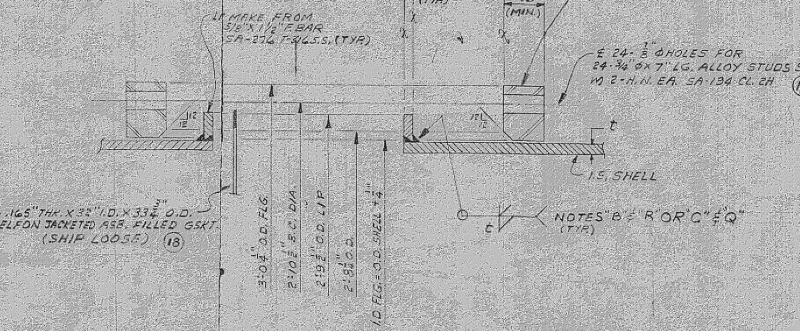I am working on a COMPRESS model for a vertical trayed tower/vessel for a customer that wants to know if it can take Full Vacuum, or alternatively what the MAEP would be. The tower is from 1963 and includes two sets of body flanges that are lap joint design (with the lap being a weld on as shown in Figure 2-4, 1(a)). I've been digging into UG-28 in Section VIII and manipulating my model, and I've yet to have COMPRESS recognize these types of flanges as a line of support. I don't believe that this flange design can be treated as a line of support when compared something like a weld neck body flange. Overall question, can anyone confirm my line of thinking?
Navigation
Install the app
How to install the app on iOS
Follow along with the video below to see how to install our site as a web app on your home screen.
Note: This feature may not be available in some browsers.
More options
Style variation
-
Congratulations cowski on being selected by the Eng-Tips community for having the most helpful posts in the forums last week. Way to Go!
You are using an out of date browser. It may not display this or other websites correctly.
You should upgrade or use an alternative browser.
You should upgrade or use an alternative browser.
Lap joint flange on a vertical tower under external pressure
- Thread starter LiewehrW
- Start date
- Status
- Not open for further replies.
LiewehrW, I'd say if your lap rings can be shown to meet UG-29 they may be treated as lines of support, if not, then not.
This is not necessarily the same thing as convincing your software that it is so.
Regards,
Mike
The problem with sloppy work is that the supply FAR EXCEEDS the demand
This is not necessarily the same thing as convincing your software that it is so.
Regards,
Mike
The problem with sloppy work is that the supply FAR EXCEEDS the demand
- Thread starter
- #4
BJI said:...beneficial effects of friction...
Care to explain this statement?
The problem with sloppy work is that the supply FAR EXCEEDS the demand
Since it is a lap flange, to transfer load from the shell to the ring, it must be by friction through the interface between the stub end and the backing flange. It may be a high load but given that there is high flange rotation (closer to line contact at edge of stub) and general thermal cycling, I would not rely on this connection to develop compressive hoop stress in the ring. The stub end is welded, provided it is suitable for the loads you could count this as a line of support for buckling. It might be a conservative approach but I can calculate it as a stiffener if required.
BJI, yes, I am sure Code recognizes no continuity between a loose flange and the lap ring. Based on the definition of L, UG-28(b), I believe the lap ring must meet the requirements of UG-29 to be considered a line of support.
The problem with sloppy work is that the supply FAR EXCEEDS the demand
The problem with sloppy work is that the supply FAR EXCEEDS the demand
- Status
- Not open for further replies.
Similar threads
- Replies
- 8
- Views
- 9K
- Question
- Replies
- 4
- Views
- 7K
- Replies
- 2
- Views
- 10K
- Locked
- Question
- Replies
- 1
- Views
- 726

